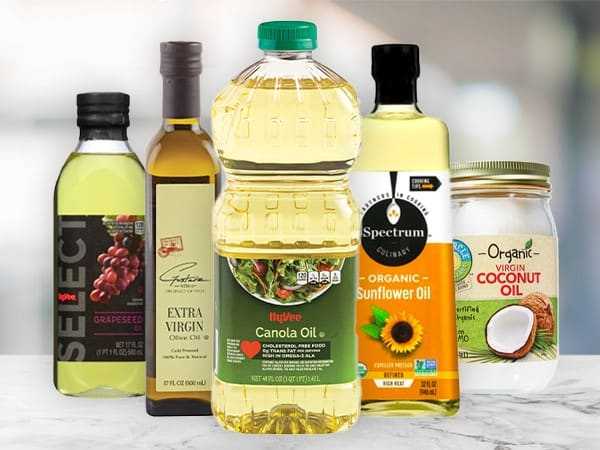What’s the healthiest oil you can cook with? It depends on what you’re looking for. Some oils are high in monounsaturated fats like olive oil, while others are better sources of polyunsaturated or saturated fat.
To help you figure out which option is best for your dietary needs, here’s a list of popular cooking oils and their fatty acid profile. All numbers represent grams per 100 g (3 1/2 oz) serving size unless otherwise noted.
Sunflower oil: 7 g (0 g trans)/90 g; 75% MUFA; 9% PUFA; 10% SFA; 2% omega-3 [1] (table)
Corn oil: 11g/100g; 79% MUFA; 13% PUFA; 7% SFA [2]
Safflower oil: 15 g/100g; 77% MUFA; 14% PUFA; 9% SFA [3] (table)
Canola oil: 17 g / 100 g ; 66 % MUFA, 16 % PUFA, 17 % SFA [4]
Peanut oil: 32 g/100g (0.8 oz); 49% MUFA; 28% PUFA; 23% SFA [5] (table)
Sunflower and corn oils are high in monounsaturated fatty acids, making them a better choice than canola and peanut oil, which contain a high percentage of polyunsaturated fatty acids.
They also have higher smoke points than canola and peanut oil do, making it more suitable for frying. Sunflower and corn oil are not as heat stable as olive oil is however, so they should be refrigerated after opening to prevent spoiling.
Safflower and safflower-oil blends have a fairly high monounsaturated fat content but lack omega-3 fatty acids completely [6] , so they’re a poor choice for people with heart disease or high blood pressure who need to limit their intake of saturated fat [7] (article in German).
Olive oil: 73 g100g; 73 % MUFA; 14% PUFA; 13% SFA [8] (table)
Olive oil has the highest monounsaturated fat content of all cooking oils, but it also contains a significant amount of polyunsaturated and saturated fatty acids.
It’s best used as a dressing for salads or pasta, not as your primary cooking fat.
Sesame oil: 49 g/100g (3 1/2 oz); 44% MUFA, 33 % PUFA, 23 % SFA [9]
Sesame oil is very high in polyunsaturated and sesaminolactone. It can help lower LDL cholesterol and triglycerides while raising HDL levels [10] However it’s not a heat stable oil, so it should never be used for frying.
Coconut oil: 87 g/100g (3 1/2 oz); 87% SFA [11] (table)
Virgin coconut oil is more nutritious than refined coconut oil, as some of its vitamins and minerals are lost during processing. It’s also more heat-stable than regular coconut oil, but it will still burn at relatively low temperatures unless you use a non-stick skillet or wok on your stovetop.
Of all the oils listed above, olive oil has the most unsaturated fats and the highest smoke point. It’s a safe choice for cooking if you’re looking to replace other high-PUFA oils like peanut and safflower oil.
Sunflower, corn, canola and peanut oils are all high in MUFAs, making them better choices than the more highly-processed safflower and safflower-oil blends. Of these four options sunflower and corn oil have the highest smoke points and lowest PUFA content, so they’re best for frying.
Olive oil is a good source of monounsaturated fats but it also contains a significant amount of saturated fat – not what you want if your goal is to lower your cholesterol or blood pressure [12] (article in German). It would be wise to limit intake by using olive oil sparingly as an additive to food rather than a main cooking oil.
Sesame oil may be high in MUFAs but it’s also very high in PUFAs [13] , meaning that although it’s better for you than highly processed seed oils [14] (article in German) it shouldn’t be your go-to cooking oil, especially if you have heart disease.
Coconut and virgin coconut oils are solid choices for healthy eating: they’re rich in saturated fatty acids and contain antioxidants like tocotrienols and tocopherols which can help lower cholesterol levels [15] . However, most foods we eat don’t require such high temperatures (smoke point is around 350 degree F) so there’s not much point in using these oils for cooking.
Finally, if you’re looking to fry foods you should choose an oil with a good balance of MUFAs and PUFAs rather than one that is predominantly monounsaturated or highly-processed and heat-stable [16] . For example, sunflower and corn oil contain high levels of both MUFAs and PUFAs while peanut oil contains almost all MUFAs.
